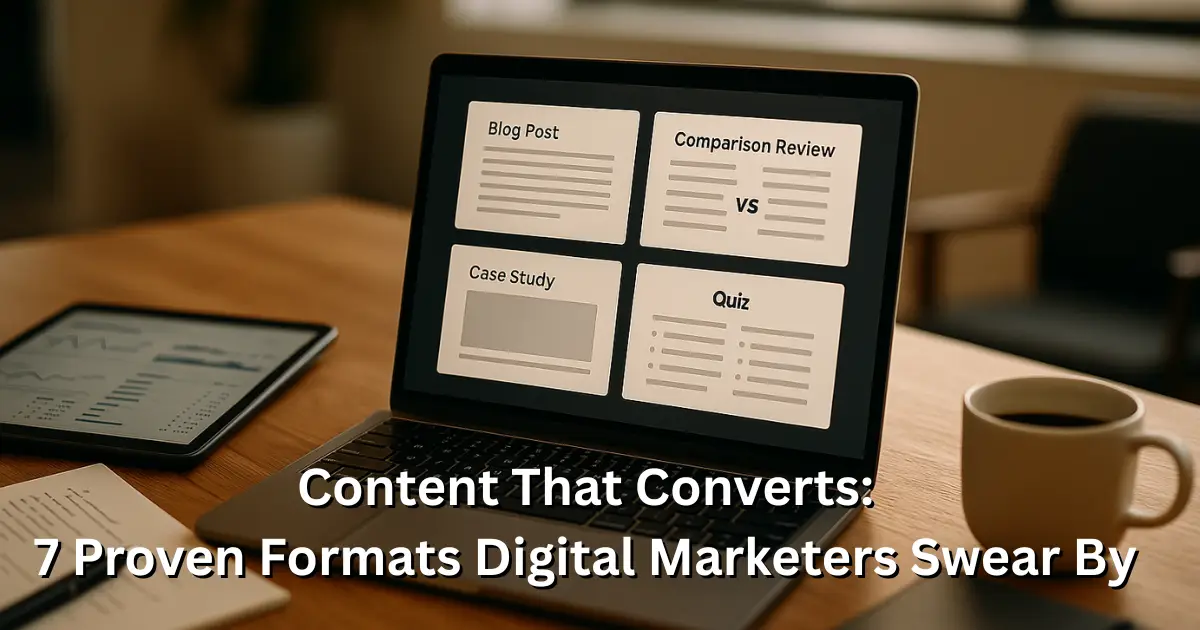Why Affiliates Should Care About Native Ads:
The Unbiased Analysis
In the competitive world of affiliate marketing, the difference between success and mediocrity often comes down to traffic quality and conversion rates. While most affiliates focus on SEO, social media, and paid search, there’s another advertising format quietly delivering exceptional results: native advertising.
Native ads have evolved from a novel concept to a $85 billion global industry, with spending projected to reach nearly $190 billion by 2028. But beyond the impressive growth numbers lies a more compelling question for affiliate marketers: Do native ads actually deliver better results than traditional advertising methods?
What Makes Native Ads Different
Native advertising refers to paid content that matches the form, feel, and function of the platform where it appears. Unlike banner ads that scream “advertisement,” native ads blend seamlessly into the user experience, appearing as natural content recommendations, sponsored articles, or promoted posts.
The fundamental difference lies in user psychology. Traditional display advertising works by interrupting the user’s browsing experience, hoping to capture attention through bold visuals and compelling offers. Native advertising takes the opposite approach—it provides value first, building trust and engagement before introducing any commercial message.
This distinction matters more than you might think. Research shows that consumers look at native ads 53% more frequently than display ads, and they’re viewed nearly as much as original editorial content. The reason? Native ads don’t trigger the mental defense mechanisms that users have developed against traditional advertising.
The Performance Advantage
The numbers tell a compelling story about native advertising effectiveness. According to industry studies, native ads achieve click-through rates that are 8.8 times higher than traditional display ads. But high click-through rates mean nothing without conversions, and this is where native advertising truly shines for affiliate marketers.
Sharethrough’s comprehensive study found that native ads generate superior engagement across multiple metrics. Users spend 25% more time engaging with native ads compared to display ads, and they’re significantly more likely to share native content with others.
Perhaps most importantly for affiliates, native ads consistently deliver better cost-per-click rates. Industry data indicates that native ads have 20% lower cost-per-click compared to search ads, while maintaining higher conversion rates due to increased user engagement.
Why Native Ads Excel with Affiliate Offers
Most affiliate offers require some level of education or trust-building before a user will take action. Whether you’re promoting software solutions, financial products, or health supplements, users rarely convert on the first touchpoint. This is where native advertising’s storytelling approach becomes invaluable.
Native ads excel at the “pre-sell”—the process of educating and building trust with potential customers before they encounter your affiliate offer. Instead of hitting users with a hard sales pitch, native ads can introduce concepts, address pain points, and provide genuine value while subtly guiding users toward your affiliate products.
Consider the difference between a banner ad screaming “LOSE 30 POUNDS IN 30 DAYS!” versus a native ad titled “How Sarah Finally Broke Through Her Weight Loss Plateau (Her Simple Strategy).” The native approach generates curiosity, provides value, and creates a natural pathway to your affiliate offer without triggering skepticism.
Content Formats That Convert
Native advertising works exceptionally well with content formats that affiliates can create and distribute at scale:
Advertorials remain one of the most effective native formats for affiliate marketing. These editorial-style articles provide in-depth information about problems and solutions while naturally incorporating affiliate products as recommended solutions. The key is ensuring the advertorial provides genuine value—readers should leave with useful information whether they click your affiliate links or not.
Educational Content and Guides perform particularly well in native placements. “How-to” articles, comparison guides, and educational resources naturally attract users who are actively seeking solutions. These content types align perfectly with native advertising’s value-first approach while creating multiple opportunities to introduce relevant affiliate products.
Quiz and Interactive Content generates exceptional engagement rates in native placements. Interactive content increases time-on-page and creates multiple touchpoints with users, providing several opportunities to present affiliate offers in a natural, helpful context.
The versatility of these formats means affiliates can adapt their content for different native platforms while maintaining consistent messaging and conversion paths.
The Strategic Advantage
If you’ve ever wondered how affiliates scale campaigns to six figures, native ads are usually in the mix. The format offers several strategic advantages that make it particularly suitable for affiliate marketing at scale.
First, native ads typically face fewer restrictions than other advertising formats. While platforms like Facebook and Google have become increasingly strict about affiliate promotions, native advertising platforms often welcome affiliate marketers who create quality content.
Second, native advertising excels at audience expansion. Once you identify a winning native campaign, you can often scale it across multiple platforms and publishers with minimal modification. According to StackAdapt’s research, programmatic native advertising allows for sophisticated targeting and optimization, enabling affiliates to reach their ideal audiences across thousands of premium publications.
Third, native ads build valuable audience data. Because native ads encourage engagement and longer interaction times, they generate rich behavioral data that affiliates can use for retargeting and audience development. This data becomes increasingly valuable for building sustainable, long-term affiliate marketing businesses.
Building Email Lists Through Native Ads
One often overlooked advantage of native advertising for affiliates is its effectiveness at building email subscribers. The trust and engagement generated by quality native content translates into higher opt-in rates for lead magnets and email subscriptions.
Users who discover your content through native advertising are often more receptive to joining your email list because they’ve already experienced value from your content. This creates an opportunity to nurture these subscribers over time, introducing them to multiple affiliate offers and building long-term customer relationships.
The key is creating a smooth transition from native content to email signup, then delivering exceptional value in your welcome sequence. A well-crafted welcome email that provides immediate value can significantly improve your affiliate conversions by building trust and establishing expectations for your email relationship.
Realistic Challenges and Considerations
Despite its advantages, native advertising isn’t without challenges for affiliate marketers. Success requires a different mindset and approach compared to traditional affiliate marketing methods.
Content creation demands increase significantly with native advertising. While banner ads can be created once and used across multiple campaigns, native ads require fresh, platform-specific content that provides genuine value. This means affiliates need strong writing skills or budget for professional content creation.
Testing and optimization become more complex with native advertising. Unlike simple banner ad tests where you might only test headlines and images, native ad optimization involves testing content angles, publication placements, audience targeting, and conversion paths. This complexity can overwhelm affiliates accustomed to simpler advertising formats.
Platform learning curves vary significantly across native advertising networks. Each platform has unique editorial standards, audience expectations, and optimization features. Success often requires time investment to understand platform nuances and audience preferences.
Success Metrics That Matter
Traditional affiliate marketing metrics like click-through rates and immediate conversions tell only part of the story with native advertising. Research from Outbrain shows that native ads excel at brand lift and consideration metrics, which translate into higher lifetime customer value for affiliate marketers.
Focus on engagement metrics like time-on-page, content completion rates, and social sharing. These indicators predict long-term affiliate success better than immediate conversion rates. Users who deeply engage with your native content are more likely to become repeat customers and higher-value conversions.
Track multi-touch attribution carefully. Native advertising often initiates customer journeys that convert through other channels. Use proper attribution models to understand native advertising’s full contribution to your affiliate revenue.
The Bottom Line for Affiliates
Native advertising offers affiliate marketers a path to higher-quality traffic, better engagement rates, and more sustainable businesses. The format aligns with modern consumer preferences for value-driven, non-intrusive marketing while providing the scale and targeting capabilities that successful affiliate campaigns require.
However, native advertising isn’t a magic solution for struggling affiliate campaigns. It requires investment in quality content creation, platform expertise, and sophisticated tracking. Affiliates who succeed with native advertising typically have solid fundamentals in place—quality products to promote, understanding of their target audience, and commitment to providing genuine value.
For affiliates willing to invest in the learning curve, native advertising provides a competitive advantage that becomes more valuable as traditional advertising channels become more saturated and restricted. The format’s emphasis on trust-building and value creation aligns with the direction of modern affiliate marketing, making it a strategic investment for long-term success.
The question isn’t whether native advertising works for affiliate marketing—the performance data clearly demonstrates its effectiveness. The real question is whether you’re ready to adapt your approach to take advantage of this powerful but demanding advertising format.




